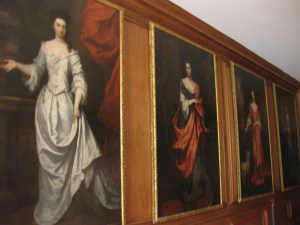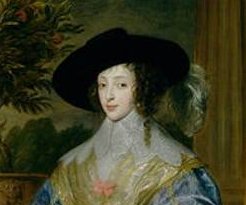By Elizabeth C. Goldsmith (Regular Contributor)
Before the days of guidebooks and tourist sites, the Eiffel Tower and the Empire State Building, voyagers who traveled for pleasure had different sightseeing practices. One of the most common points of discussion in European travel accounts of the seventeenth century was the beauty of women in foreign lands. Such commentary quickly took on a competitive aspect. Were Italian ladies more beautiful than the French? Could the English ladies compete with the Spanish? Artists rushed to fulfill commissions for portraits that would prove the case.
Postcard beauties
Prominent noblemen, happy to make their own palaces worthy of mention in traveler accounts, set up rooms in their residences devoted to displaying portraits of the most beautiful women of their nation. The Flemish painter Jacob-Ferdinand Voet produced a number of ‘beauties series’ paintings for the private galleries of Italian nobleman. These proved so popular that he was asked to complete similar commissions for the Duke of  Savoy and other European noblemen. The painter Peter Lely, based in London, produced a collection of portraits for the residence of the Duchess of York and the Earl of Sutherland that were dubbed ‘The Windsor Beauties’. (This collection can still be viewed at Hampton Court Palace in England). These portraits were reproduced as prints and circulated by travelers, like postcards.
Savoy and other European noblemen. The painter Peter Lely, based in London, produced a collection of portraits for the residence of the Duchess of York and the Earl of Sutherland that were dubbed ‘The Windsor Beauties’. (This collection can still be viewed at Hampton Court Palace in England). These portraits were reproduced as prints and circulated by travelers, like postcards.
Counterculture Beauty Commentary
Women were able to travel as tourists much more easily by the seventeenth century, as improved roads and regularly scheduled public carriages made it safe and practical for voyagers to travel independently. How did female travelers respond to the fashion of beauties series contests? Some women, like Sophia of Hanover, were known for their fondness for travel. Sophia eagerly entered into the discussion of national beauty competitions. In her memoirs she describes how her hosts would organize beauty contests for her amusement. But she was skeptical of the whole exercise, and she took some pleasure in debunking it. She had already noticed that portraits done of herself in her youth were ridiculously flattering. In fact, she writes, “I was skinny and ugly as a child.” When she traveled to England she reported on her impressions of Queen Henrietta Maria and the ladies of her court, all of whom she had previously seen in popular prints of portraits done by the famous artist Van Dyck. Her commentary is a critique of the portraits as well as the whole pretense of the beauty contest:
 “The fine portraits by Van Dyck had given me a lofty idea of the beauty of all English ladies. I was therefore surprised to discover that the Queen, so beautiful on canvas, was actually a short woman … with long wizened arms, crooked shoulders, and teeth portruding from her mouth like ravelins from a fortress.”
“The fine portraits by Van Dyck had given me a lofty idea of the beauty of all English ladies. I was therefore surprised to discover that the Queen, so beautiful on canvas, was actually a short woman … with long wizened arms, crooked shoulders, and teeth portruding from her mouth like ravelins from a fortress.”
For further reading:
Sophia of Hanover, Memoirs. Ed. and trans. Sean Ward (2013)
Melville, Lewis. The Windsor Beauties: Ladies of the Court of Charles II (2005)

